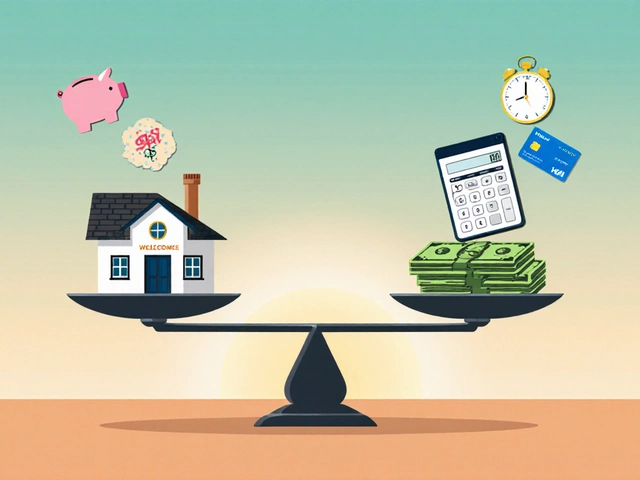Finding a place that's friendly on the wallet can feel like searching for a needle in a haystack! You might think it’s all about the rent, but boy, there’s more to it. From groceries to gas, these little expenses can pile up faster than you can say "budget." So, where in the U.S. can you keep these costs under control?
Well, the answer isn't some swanky city or buzzing metropolis. Often, it's the spots that fly under the radar that pack the biggest bang for your buck. States like Mississippi, Arkansas, and Oklahoma often come up top on the list for having the lowest overall living costs. Each of these places has its own charm, but what unites them is how much you can save while living comfortably.
- Look Beyond Just Rent
- Checking the Essentials
- Lifestyle Meets Wallet
- Getting the Most Bang for Your Buck
Look Beyond Just Rent
When it comes to figuring out where the cheapest state might be, it's tempting to just zoom in on rent prices. But hold on a second—there's more to the picture. If you've ever paid a utility bill or a grocery tab, you know rent's just one piece of the puzzle!
For starters, think about the cost of utilities. Places known for cheaper living costs sometimes have lower electric and water bills. For example, Mississippi not only offers one of the lowest housing costs but it also boasts relatively cheap utilities. That’s because of local energy resources and not-so-harsh weather, which can keep heating and cooling bills down.
And don’t forget about groceries! Believe it or not, where you live can totally affect your grocery bill. In certain states, the cost of fruits, veggies, and even a carton of milk can vary by a ton. Generally, southern states like Arkansas and Oklahoma enjoy lower food prices thanks to local agriculture and shorter transport times from farms to stores.
Oh, and transportation costs can make or break your budget too. If you live far from work, commute costs can skyrocket. Some states offer cheaper gas and public transportation, which is a lifesaver for your wallet.
To give you an idea, here's how some states stack up in terms of these everyday expenses:
| State | Average Monthly Rent | Utility Costs | Grocery Costs | Transportation Costs |
|---|---|---|---|---|
| Mississippi | $850 | $130 | $300 | $100 |
| Arkansas | $900 | $120 | $320 | $90 |
| Oklahoma | $870 | $110 | $310 | $95 |
So, while scoping out the lowest rent is smart, don't ignore these other costs. They can sneak up on you if you're not careful. Living in a state with nice balance across all these expenses means more savings and less financial stress for you.
Checking the Essentials
When it’s time to double-check your cost of living strategy, you’ve got to look beyond the obvious. Sure, the rent is crucial, but what about other everyday expenses? It’s the hidden costs like utilities, groceries, and transportation that can trip you up.
Take utilities, for instance. In a state like Arkansas, you might pay much less for electricity compared to, say, New York. And groceries? States with lower living costs often boast cheaper food prices as well, making it easier to keep your pantry stocked without breaking the bank.
- Utilities: It may be surprising, but lower demand areas often mean lower prices for electricity, water, and gas. Consider exploring renewable energy options which could save you even more.
- Groceries: Local produce and farming can sometimes make a big difference in what you pay. Markets in lower-cost states typically source locally, which can slash costs.
- Transportation: Public transport options or shorter commutes significantly cut travel expenses. Check if the state has good public transportation or bike-friendly routes.
- Healthcare: Costs can vary widely, but states with lower living expenses tend to have more affordable healthcare services.
Let’s look at some potential savings in a quick table:
| Expense Category | High-Cost State | Low-Cost State |
|---|---|---|
| Utilities (monthly) | $150 | $100 |
| Groceries (weekly) | $150 | $90 |
| Transportation (monthly) | $200 | $120 |
It doesn’t seem like much at first glance, but over time, these small differences add up. If every dollar counts, paying attention to these seemingly minor details can make living in a cheapest state feel like a great deal.

Lifestyle Meets Wallet
Let's get real—moving isn't just about cutting costs. You need a place that fits your lifestyle too. It’s where affordable housing meets a little bit of fun, work-life balance, and stuff that makes life living. Take a state like Mississippi, for example. It's not only known for having the cheapest state badge, but it also dishes out culture with its music festivals and has a decent nightlife that's not going to burn a hole in your wallet.
If you're more into the great outdoors, Arkansas might tick all the right boxes. It’s got lush natural parks while still being easy on your budget. National parks there, like the Ozarks, offer beautiful hiking trails and picturesque campsites without ending up a costly adventure.
Let’s not forget about food, right? In Oklahoma, you'll find everything from mouth-watering BBQ to local diners that won’t break your bank. Oklahoma City even ranked high on being cost-effective for dining out, thanks to lower-than-average food prices.
Here’s something neat for the super planners out there. Check this simple breakdown of some lifestyle costs in these states:
| State | Cost of Monthly Groceries (USD) | Average Night Out Cost (USD) |
|---|---|---|
| Mississippi | $250 | $30 |
| Arkansas | $240 | $28 |
| Oklahoma | $245 | $32 |
See, keeping your expenses light doesn’t mean giving up on good living. It’s all about finding places where the cost of living lets you enjoy life too. Whether it’s live music, hiking, or just grabbing a bite, these states offer a slice of life without slicing your wallet.
Getting the Most Bang for Your Buck
Want to make your dollars stretch further? It's not just about finding the lowest rent. Many folks forget to take note of the other everyday expenses that can eat away at your budget. Let’s break down how you can maximize your spending power in states with the lowest cost of living.
First off, keep an eye on groceries, utilities, and transportation. While you might save on rent in some areas, if you're paying through the nose for these other bits, you might not be saving as much as you think. For instance, in Mississippi, you’ll find that utility bills often cost less than the national average, which keeps more money in your pocket for other essentials or even a bit of spontaneous fun.
Next up is transportation. If you can ditch the car, especially in urban areas with public transit systems, that’s another big savings opportunity. In Oklahoma, for example, residents enjoy cheaper gas prices, making owning a car less of a burden compared to pricier states.
Let's not forget health care. States like Arkansas offer lower healthcare costs, which is a big plus if you’re considering long-term savings. Combine that with affordable housing and you start seeing why these places are so appealing.
Here's a quick glance at how some key expenses fare in these states:
| State | Average Utility Cost (per month) | Average Gas Price (per gallon) | Healthcare Ranking |
|---|---|---|---|
| Mississippi | $121 | $3.05 | 8th lowest |
| Arkansas | $123 | $3.07 | 10th lowest |
| Oklahoma | $127 | $2.95 | 15th lowest |
So, if your goal is to get the most out of every dollar, think about more than just what you’re paying for rent. By looking at the full picture, you’ll find the true gems of affordable living, with the added bonus of enjoying a lifestyle that won’t squeeze your wallet.





